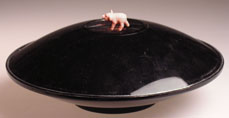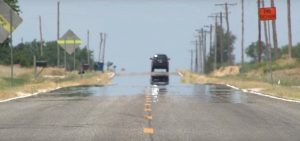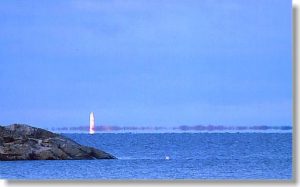Equipment:
- Mirage Apparatus
- Small Plastic Pig
Demo:
The instructor can place any small object in the center of the lower parabolic mirror. After resting the upper mirror on top the object appears to float above the mirrored circle in full color and three dimensions. The students could be invited to look at the object (little piggy) from all sides and try to touch it.
Explanation:
The small plastic pig is placed at the center of the lower parabolic mirror. The design of this demonstration places the upper parabolic mirror at the focal length of the lower parabolic mirror. This will result in all of the light rays that come from the center of the lower parabolic mirror to be reflected straight down back towards the lower parabolic mirror. Then, these light rays will reflect off of the lower parabolic mirror and converge at the center of the upper parabolic mirror. The diagram below depicts how this works.

Figure 2: Light rays reflect off of an object inside the apparatus and converge at the opening to produce a holographic image of the object.
For more information about how this demonstration works, see “A Complete Ray-trace Analysis of the ‘Mirage’ Toy” by Sriya Adhya and John Noé. http://laser.physics.sunysb.edu/~john/ETOP/Mirage-paper.pdf
This phenomenon may also witnessed in everyday life. In principle, light follows the path of least action, which is depicted by Snell’s Law. The UCSC demo webpage for the Reflection and Refraction Tank goes in to detail about this law.
One example of a mirage in everyday life is best seen on a warm day while you are driving, and you notice a car approaching you on a small, two-lane road. Obviously, you are able to see the car, since light is reflect from the car and directly enters your eyes. However, there is another image you witness.
The light that reflects off of the car also heads towards the asphalt. The air near the surface of the asphalt is warmer than the air a few feet above it (or more). By Snell’s Law, and thus by “principle of least action”, the light approaching this boundary of air will change the path it travels on, and curve slightly up. This is similar to how a laser will change its path while changing its medium from air to water. These light rays will eventually converge to form an image just above the asphalt, which you are able to see. This is shown in Figure 3.
Not only are you able to see the physical car in front of you, but you also see an image of the car just above the asphalt. This phenomenon is not just limited to cars though.
Let us look at a different case. Instead of hot air being contained below cooler air, let us examine the case where cool air is below warmer air. This is best seen on a warm day at the beach. The ocean absorbs heat quite well, which results in the air above its surface being cooler than the air a few feet above it (or more). Say that just below the horizon, there is a cargo ship, but you, at this moment do not know it is there. By the same principle stated above, the light that is reflected off of the cargo ship will take the path of least action. This means that the some of the light reflected off of the cargo ship will cross the boundary of the cool air and the warm air, where Snell’s Law may be noticed. This will bend the light, which will converge and form an image, of which you are able to see. This is shown in Figure 4.
This means it is possible to see an image of an object that is beyond the horizon! For more images and explanations of this phenomena, visit the following website: https://finland.fi/life-society/mirages-in-finland/
Written by Ryan Dudschus.


